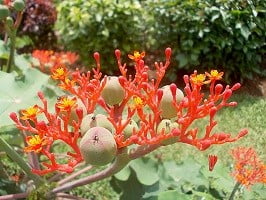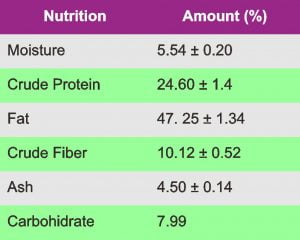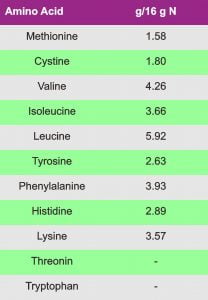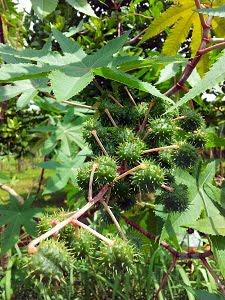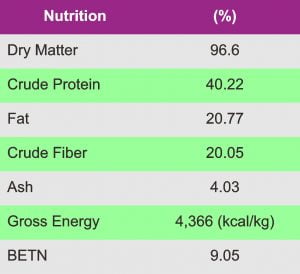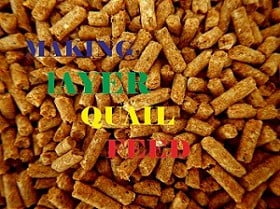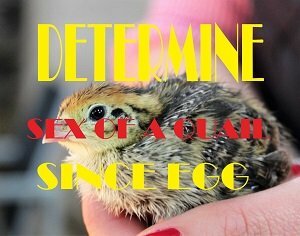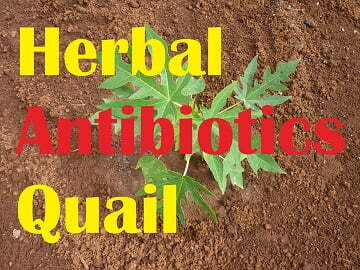You must be familiar with this one plant. Yes, this is a castor plant.
In the past, in my place, every field and garden fence was this plant. But now it is no longer there because it is replaced by another plant.
Maybe because they don’t know the benefits, other than as a fence, so this plant is cut down. Besides, the planting was also forced first.
Forced by the Japanese, that’s the history.
However, nowadays, quite a lot of jatropha is used. Among them, the oil is taken.
This is because the oil content is quite high. That is about 30% of the dry seeds.
However, extracting oil from jatropha seeds requires a fairly long process.
Then the by-product is in the form of Oilcake which I will discuss in this article.
Why? This is the reason.
If your location is close to the processing of castor beans to make biodiesel, then the by-product in the form of cake is quite a lot.
Maybe we can get it easily.
But, if you find that your location is far away, just consider this article for information only.
The nutritional content of Jatropha Oilcake
Jatropha oilcake has high nutritional content. If this could be used as animal feed, it would be very profitable.
Because according to research, the nutritional content of Jatropha oilcake is as follows. [1]
The nutritional value of the Jatropha oilcake above is in fresh condition. If it is in dry matter, the value will be even greater.
For numbers after the ± sign is the deviation value. It means like this.
I take the example of the crude protein. In the picture above the value is 24.6 ± 1.4.
This means that the crude protein value ranges between (24.6 – 1.4 = 23.2) and (24.6 + 1.4 = 26).
Likewise for other nutritional content.
Not bad the nutritional value of this Jatropha oilcake, right?
Not only the nutritional content is high enough, but the crude protein from this Jatropha oilcake also has a fairly complete amino acid composition.
This is the amino acid composition of Jatropha cake. [2]
There are types of jatropha that have a much higher nutrient content of oilcake. Namely the castor Ricinus communis Linn plant
The nutritional content of Ricinus communis linn is as follows. [3]
Then, can this Jatropha Oilcake be used for feed?
In theory, this jatropha cake can be used as a feed. Look at the nutrient content and amino acid composition.
In theory, it is very possible.
However, there are drawbacks to this Jatropha cake.
What are they? This is it.
First. This castor oilcake is hard to come by. Only in certain areas. Especially that there is the processing of castor seed oil.
Second. Jatropha seeds cannot be given to livestock directly. Either ruminants or poultry, don’t. Dangerous! This is because jatropha contains poisonous compounds. Later explained.
Third. Even though it is in the form of oilcake, this feed ingredient still contains harmful antinutrients.
The antinutrients in Jatropha seed meal can reduce the production and quality of livestock products.
Fourth. The processing from castor seeds to safe oilcake is quite a long process. This will require a sizable investment. So it is less efficient in terms of business.
Except, this jatropha cake can be obtained free of charge. Or, someone sells it in processed conditions and is safe for livestock.
Anti nutrition of castor
The main anti-nutritional substances in castor oil cake are curcin and phorbol ester. These two substances are not only anti-nutritional, they are both poisons.
If eaten by livestock, it can die in a short time.
The amount of phorbol ester in this Jatropha oilcake is 24 micrograms for every gram.
For curcin, the amount is not more than 0.09% in the oilcake.
The amount of poison is this many animals can die in a short time if they eat Jatropha oilcakes fresh.
This phorbol ester causes tumors. Also, this substance has carcinogenic, laxative properties, and can cause skin irritation, hangover, vomiting, and diarrhea.
In contrast to phorbol ester, curcin is more detrimental to the digestive system.
Curcin can inhibit the overall absorption of nutrients. Not only the absorption of protein, the absorption of carbohydrates, fats, and fiber will also be disrupted.
That way, livestock will experience drastic nutritional deficiencies.
Unfortunately, the anti-nutritional content of this jatropha cake is very dangerous. If none of these, the nutritional content is very good.
Then, can’t these anti-nutrients be eliminated?
You can. But the method is quite complicated and requires higher skill.
Three methods can be used to get rid of this anti-nutrient castor oilcake. The methods are physical, chemical, and biological methods.
Alternatively, the way to remove anti-nutrients from jatropha cake is a combination of the three.
The first way is to heat the jatropha cake at a temperature of 120 0C for 30 minutes. Then the cake was washed with 92% methanol 5 times.
I still have no information whether after this treatment the meal is safe for animal feed or not. Because the material used is methanol.
But according to a scientific publication journal, in this way, the phorbol ester value of Jatropha cake can be reduced to 94.94%. [2]
If we do this, we need a lot of money. Because at least we must have an oven. The oven should be large too.
If it’s small, it seems that it makes production costs higher.
Another alternative is by biological means. This method is better known as fermentation.
Removing anti-nutrients from castor oilcakes by fermentation is indeed easier and cheaper to do.
However, the results are still better physically and chemically.
Fermented jatropha cake with tempeh yeast
This fermentation is a step taken to test castor oilcake against quails.
The bacteria used were rhizopus oligosporus. These bacteria are usually used to make tempeh.
The fermentation method is as follows.
Prepare the castor oilcake. Not the seeds, but the oilcakes. Ground seeds and oilcakes are different. For the oilcake, most of the oil content has been taken.
The amount of oilcake is within our ability to get it. May be 1 kg, 10 kg, and so on.
Then, add the castor oilcake with water until the level is 60%. An easy way to find out is when the oilcake is clenched into a fist, it doesn’t leak water, but if the hand is opened, the oilcake doesn’t spread (dissolve).
After that, steam the oilcake for 1 hour. When finished, remove and cool to room temperature.
The next step is to mix the oilcake with the fermentation starter. Every 1 kg of castor oilcake, plus 7 grams of rhizopus oligosporus bacteria.
Then put in a tray and cover with plastic. The plastic is punched in small pieces. On the plate is covered again with an opaque material, for example, newspapers.
Let stand for 2 days.
After that, dry the oilcake at 60 0C for 24 hours.
Fermented castor oilcake for quail feed
Not many have done research on castor oilcake for quail feed.
In my opinion, this is because the goods are difficult to find. Its existence is uneven in the territory of Indonesia.
After all, this oilcake is not an urgent industrial waste that must be utilized.
Also, the antinutrient content is quite dangerous, and to get rid of it, it is not easy.
From a study that has been conducted, using castor oil cake as much as 3% in quail feed has shown a decrease in egg quality. [2]
The results were even worse with the use of castor seed oilcake as quail feed.
The amount of castor oilcake 1.5 – 4.5% in the feed causes the performance of the quail to decrease. [3]
Starting from ration consumption, drinking consumption, egg production, and egg weight decreased. The greater the number of oilcakes the distance, the greater the drop.
So, I did not provide complete information on the results of the research, because the results were not good enough.
Later it will make you discouraged.
Conclusion
#. No need to use jatropha oilcakes or casters for animal feed. Unless you have a castor bean processing business and have a lot of this castor oilcake waste.
So to save on production costs, you can process them so that they can be utilized.
#. To be able to take advantage of this distance oilcake requires a lot of investment.
At least we have laboratory analysis data regarding the amount of anti-nutritional value from the castor oilcake that we process.
Reference
[1] Khalim, Ismail Rahmad. 2012. The Effect of Jatropha curcas L. Fermentation of Rhizopus Oligosporus on Quality of Quail Eggs. Department of Nutrition and Feed Technology, Faculty of Animal Science, Bogor Agricultural University.
[2] Santosa, Fitri Agustini. 2012. Egg Yolk Follicles and Organs in Quail Given with Jatropha curcas L. Fermented Rhizopus oligosporus seed meal. Department of Nutrition and Feed Technology, Faculty of Animal Science, Bogor Agricultural University
[3] Ningtyas, Verry Nugraha. 2007. The effect of substitution of soybean meal with castor seed meal (Ricinus communis linn) on the performance of quail (Coturnix coturnix japonica) in the egg-laying period. Study Program of Nutrition and Feed Technology, Department of Animal Nutrition and Feed Technology, Faculty of Animal Husbandry, IPB Bogor.
 JOYNIM FARM Goat Farming, Cattle Farm, Laying Hens, Quail Farm, Gardening
JOYNIM FARM Goat Farming, Cattle Farm, Laying Hens, Quail Farm, Gardening
